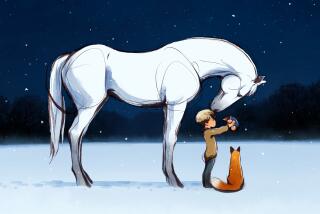Movie review: ‘My Dog Tulip’
- Share via
“My Dog Tulip” is as disconcerting and unusual a piece of animation as the 1956 memoir that inspired it, and that is saying a lot.
The story of the transformative relationship between a man and his dog, “Tulip” should not be confused with contemporary manifestations of canine rapture of the “Marley and Me” variety.
For one thing, British man of letters J.R. Ackerley was a sharp observer of human foibles and a transcendent prose stylist. Superbly read by Christopher Plummer, Ackerley’s words form the film’s voice-over narration, and they are a pleasure to listen to.
As much of a joy to the eye as that language is to the ear are the visuals of the veteran animation team of Paul and Sandra Fierlinger. Their work is fluid and lovely, a painterly kind of animation that looks almost like watercolors come to life.
This is especially noteworthy because though Paul Fierlinger estimates the film comprises close to 60,000 drawings, none of them were done on paper. Rather, the animators used a computer system that allowed them to hand-draw and hand-color on a screen using a technology called TVPaint, or TVP for short. The results are remarkable.
What makes “My Dog Tulip” such a disorienting experience on the screen and the page is that Ackerley is so completely devoted to Tulip (a German shepherd he refers to as an Alsatian) that he rhapsodizes at unexpected length about the different ways and circumstances in which she urinates and defecates.
More than that, intent on seeing to it that Tulip has a full dog’s life, Ackerley also goes into considerable clinical detail about what happens to her when she goes into heat — as well as the trials and tribulations of finding a suitable male dog to mate her with. It is all written in lapidary prose and gracefully animated, but it does take getting used to.
What is easy to understand is the depth of Ackerley’s love for the animal he says he spent the best 15 years of his life with. The film opens with type on screen quoting the author claiming “unable to love each other, the English turn naturally to dogs,” but there is more to it than that.
In fact, perhaps the film’s most moving sections involve Plummer voicing Ackerley’s lifelong yearning to find the ideal friend, someone who would suit him exactly. Nothing surprised him more than discovering that that friend would turn out to be a dog.
That admiration was mutual. “If she had her way,” says Plummer’s Ackerley, “she would never let me out of her sight.” In fact, explains kindly vet Miss Canvenini (voiced by Isabella Rossellini), Tulip was so focused on protecting Ackerley that she could focus on nothing else.
Other people turn out to be less understanding of Tulip’s vagaries. Ackerley’s feckless sister Nancy (voiced by the late Lynn Redgrave in her last released film) tries to steal the dog’s affections, and Ackerley’s other friends never invite Tulip over twice.
That’s because, as even the writer admits, Tulip was a double handful as a visiting dog, a ferocious barker that caused chaos wherever she went. Ackerley, besotted by Tulip’s undying affection, couldn’t have cared less. Such are the hallmarks of mutual love.
Accurately animated by the Fierlingers as a British writer out of central casting, down to his disorganized office and rumpled sweater vest, Ackerley was more than simply bowled over by canine passion.
Not the most optimistic individual, the writer was struck on his first day with Tulip that “it was touching and strange that she should find the world so wonderful.” That sense of admiring respect and appreciation for this devoted animal never left Ackerley and emotionally animates this most unusual film.
More to Read
Only good movies
Get the Indie Focus newsletter, Mark Olsen's weekly guide to the world of cinema.
You may occasionally receive promotional content from the Los Angeles Times.











